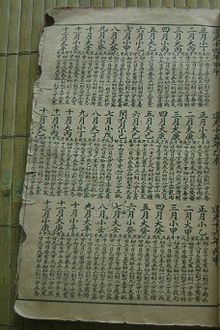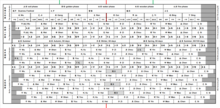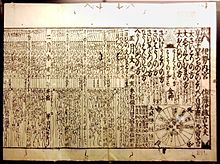Lunisolar calendar

Alunisolar calendaris acalendarin manycultures,incorporatinglunar calendarsandsolar calendars.The date of lunisolar calendars therefore indicates both theMoon phaseand the time of thesolar year,that is theposition of the Sunin the Earth'ssky.If thesidereal year(such as in asidereal solar calendar) is used instead of the solar year, then the calendar will predict theconstellationnear which thefull moonmay occur. As with all calendars which divide the year into months there is an additional requirement that the year have a whole number of months. In some cases ordinary years consist of twelve months but every second or third year is anembolismic year,which adds a thirteenthintercalary,embolismic, or leap month.


Their months are based on the regular cycle of the Moon's phases. So lunisolar calendars arelunar calendarswith – in contrast to them – additional intercalation rules being used to bring them into a rough agreement with the solar year and thus with the seasons.
Examples[edit]
TheChinese,Buddhist,Burmese,Assyrian, Hebrew,JainandKurdishas well as the traditional Nepali,Hindu,Japanese,Korean,Mongolian,Tibetan,andVietnamesecalendars (in theEast Asian Chinese cultural sphere), plus the ancientHellenic,Coligny,andBabylonian calendarsare all lunisolar. Also, some of the ancientpre-Islamiccalendars insouth Arabiafollowed a lunisolar system.[1]The Chinese, Coligny and Hebrew[a]lunisolar calendars track more or less the tropical year whereas the Buddhist and Hindu lunisolar calendars track the sidereal year. Therefore, the first three give an idea of the seasons whereas the last two give an idea of the position among the constellations of the full moon.
Chinese lunisolar calendar[edit]
TheChinese calendarorChinese lunisolar calendaris also called Agricultural Calendar [ nông lịch; nông lịch; Nónglì; 'farming calendar'], or Yin Calendar [ âm lịch; âm lịch; Yīnlì; 'yin calendar']), based on the concept ofYin Yang[citation needed]and astronomical phenomena, as movements of the sun, moon, Mercury, Venus, Mars, Jupiter and Saturn (known as the seven luminaries) are the references for the Chinese lunisolar calendar calculations.[citation needed]The Chinese lunisolar calendar is believed to be the origin of some variant calendars used in other neighboring countries, such as Vietnam and Korea.
The traditional calendar calendars used thesexagenarycycle-basedganzhisystem's mathematically repeating cycles ofHeavenly StemsandEarthly Branches.[citation needed]Together with astronomical, horological, andphenologicalobservations, definitions, measurements, and predictions of years, months, and days were refined. Astronomical phenomena and calculations emphasized especially the efforts to mathematically correlate the solar and lunar cycles from the perspective of the earth,[citation needed]which however are known to require some degree of numeric approximation or compromise.
The earliest record of the Chinese lunisolar calendar was in theZhou dynasty(1050 BC – 771 BC, around 3000 years ago.[2]Throughout history, the Chinese lunisolar calendar had many variations and evolved with different dynasties with increasing accuracy, including the "six ancient calendars" in theWarring States period,the Qin calendar in theQin dynasty,the Han calendar or the Taichu calendar in theHan dynastyandTang dynasty,the Shoushi calendar in theYuan dynasty,and the Daming calendar in theMing dynasty,etc. Starting in 1912, the solar calendar is used together with the lunar calendar in China.
The most celebrated Chinese holidays, such asSpring Festival(Chunjie, Tết Âm Lịch ), also known as theChinese New Year,Lantern Festival( tết Nguyên Tiêu ),Mid-Autumn Festival( Tết Trung Thu ),Dragon Boat Festival( Tết Đoan Ngọ ), andQingming Festival( tết Thanh Minh ) are all based upon theChinese lunisolar calendar.In addition, the popularChinese zodiacis a classification scheme based on theChinese calendarthat assigns an animal and its reputed attributes to each year in a repeating twelve-year cycle.
[edit]
TheGregorian calendar(the world's most commonly used) is a solar one but theWestern Christian churchesuse a lunar-based algorithm to determine thedate of Easterand consequentmovable feasts.[3]Briefly, the date is determined with respect to theecclesiastical full moonthat follows theecclesiastical equinoxin March. (These events are almost, but not quite, the same as the actual astronomical observations.) TheEastern Christian churcheshave a similar algorithm that is based on theJulian calendar.
Reconciling lunar and solar cycles[edit]
Determining leap months[edit]
This sectionneeds additional citations forverification.(July 2021) |
Atropical yearis approximately 365.2422dayslong and asynodic monthis approximately 29.5306 days long,[4]so a tropical year is approximately365.2422 / 29.5306 ≈ 12.36826months long. Because 0.36826 is between1⁄3and1⁄2,a typical year of 12 months needs to be supplemented with one intercalary or leap month every 2 to 3 years. More precisely, 0.36826 is quite close to7⁄19(about 0.3684211): several lunisolar calendars have 7 leap months in every cycle of 19 years (called a 'Metonic cycle'). TheBabyloniansapplied the 19-year cycle in the late sixth century BCE.[5]
Intercalation of leap months is frequently controlled by the "epact",which is the difference between the lunar and solar years (approximately 11 days). The classic Metonic cycle can be reproduced by assigning an initial epact value of 1 to the last year of the cycle and incrementing by 11 each year. Between the last year of one cycle and the first year of the next the increment is 12 – thesaltus lunae(Latinfor 'leap of the moon') – which causes the epacts to repeat every 19 years. When the epact reaches 30 or higher, an intercalary month is added and 30 is subtracted. The Metonic cycle states that 7 of 19 years will contain an additional intercalary month and those years are numbered: 3, 6, 8, 11, 14, 17 and 19. Both the Hebrew calendar and the Julian calendar use this sequence.[citation needed]
The Buddhist and Hebrew calendars restrict the leap month to a single month of the year;[citation needed]the number of common months between leap months is, therefore, usually 36, but occasionally only 24 months. Because the Chinese and Hindu lunisolar calendars allow the leap month to occur after or before (respectively) any month but use the true apparent motion of theSun,[citation needed]their leap months do not usually occur within a couple of months ofperihelion,when the apparent speed of the Sun along theeclipticis fastest (now about 3 January). This increases the usual number of common months between leap months to roughly 34 months when a doublet of common years occurs, while reducing the number to about 29 months when only a common singleton occurs.[citation needed]
With uncounted time[edit]
An alternative way of dealing with the fact that a solar year does not contain an integer number oflunar monthsis by including uncounted time in a period of the year that is not assigned to a named month.[6]SomeCoast Salish peoplesused a calendar of this kind. For instance, theChehalisbegan their count of lunar months from the arrival of spawningchinook salmon(in Gregorian calendar October), and counted 10 months, leaving an uncounted period until the next chinooksalmon run.[7]
List of lunisolar calendars[edit]
The following is a list of lunisolar calendars sorted by family.
- Babylonian calendarfamily – common use of the Metonic cycle
- Hindu calendarfamily – shared astronomical roots
- Assamese calendar
- Bikram Samvat
- Burmese calendar(Pyucalendar)
- Nepal Sambat( "Nepali calendar" )
- Odia calendar
- Pawukon calendar
- Shaka Samvat
- Suriyayatra calendar
- Vira Nirvana Samvat(Jaincalendar)
- Chinese calendarfamily – years start on second new moon after winter solstice (save for leaps)
- Unclassified or independent
- Attic calendar
- A lunisolar calendar devised byPlethon,né Georgios Gemistos, in his Book of Laws
- Egyptian calendar, Ptolemaic
- Inca Empire
- Celtic calendar,includingColigny calendar
- Muisca calendar
- Nisg̱a'a
- Old Eastern Ojibwe calendar
- Javanese calendar
See also[edit]
- List of calendars
- Callippic cycle
- Calendar reform
- Nasi'
- Other non-solar calendars
- Roman calendar(probably a lunisolar calendar withcommon yearsof 355 days andleap yearsof 378 days.)
- Rune calendar
- Tamil calendar
Notes[edit]
- ^The modern Hebrew calendar, since it is based on rules rather than observations, does not exactly track the tropical year, and in fact the average Hebrew year of about 365.2468 days is intermediate between the tropical year (about 365.2422 days) and the sidereal year (about 365.2564 days).
References[edit]
- ^F.C. De Blois, "TAʾRĪKH": I.1.iv. "Pre-Islamic and agricultural calendars of the Arabian peninsula",The Encyclopaedia of Islam,2nd edition,X:260.
- ^Xu, Zhaofeng."Considering Chengzhou (" Completion of Zhou ") and Wangcheng (" City of the King ")"(PDF).Chinese Achaeology.8:172–177. Archived fromthe original(PDF)on 2015-07-22.Retrieved2023-09-20.
- ^Richards, E. G. (2013). "Calendars". In Urban, Sean; Seidelmann, P. Kenneth (eds.).Explanatory Supplement to the Astronomical Almanac(3rd ed.). Mill Valley, CA: University Science Books. pp. 583, 592, §15.4.ISBN978-1-891389-85-6.
- ^P. Kenneth Seidelmann, ed. (1992).Explanatory Supplement to the Astronomical Almanac.p. 577.
For convenience, it is common to speak of a lunar year of twelve synodic months, or 354.36707 days.
(which gives a mean synodic month as 29.53059 days or 29 days 12 hours 44 minutes and 3 seconds) - ^van Gent, R.H. (July 2021)."The Babylonian Calendar".Utrecht University.
- ^Nilsson, Martin P.(1920), "Calendar Regulation 1. The Intercalation",Primitive Time-Reckoning: A Study in the Origins and First Development of the Art of Counting Time among the Primitive and Early Culture Peoples,Lund: C. W. K. Gleerup, p. 240,
The Lower Thompson Indians in British Columbia counted up to ten or sometimes eleven months, the remainder of the year being called the autumn or late fall. This indefinite period of unnamed months enabled them to bring the lunar and solar year into harmony.
- ^Suttles, Wayne P.Musqueam Reference Grammar,UBC Press, 2004, p. 517.
Further reading[edit]
- Dershowitz, Nachum;Reingold, Edward M.(2008).Calendrical Calculations.Cambridge: Cambridge University Press.ISBN9780521885409.
External links[edit]
- Introduction to CalendarsArchived2019-06-13 at theWayback Machine,US Naval Observatory, Astronomical Applications Department.
- Luni-Solar Calendar

